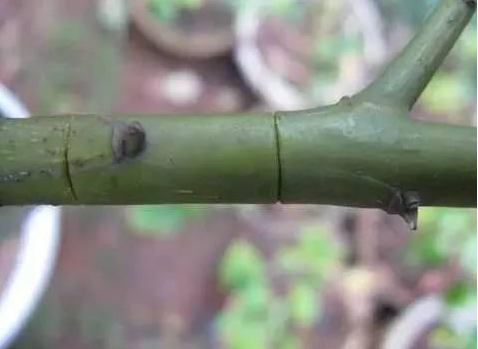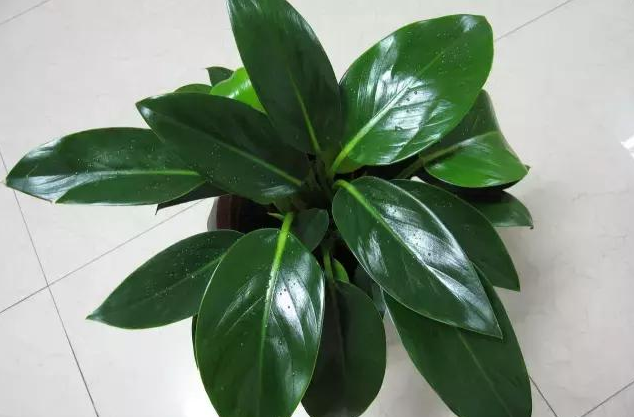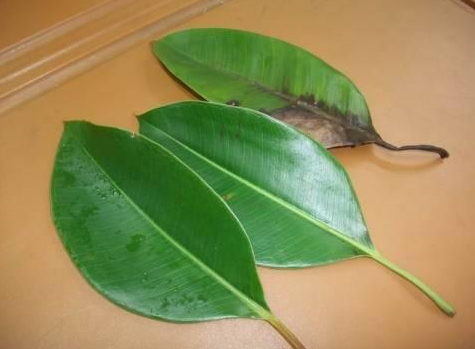How long does it take for roses to be striped and propagated?
To talk about this rose, this is a lot of people like to breed, this rose can also be reproduced, let's see how to achieve rose striping reproduction? How long does it take to press the rose to root:

How to achieve rose striping reproduction:
1. Select and propagate branches
Of course, it is necessary to choose woody rose branches that have grown for a year or two, as shown in the following picture, which are carried out at the lower end of the branch. you can see that the selected branches are cut with a sterilized sharp knife, which can be disinfected in many ways, which can be directly scalded or sprayed with fungicides, and different roses should be sterilized before cutting to avoid cross-infection.
2. Attention to cutting
Ring peeling is a very simple thing, only need to prepare a sharp knife, some plants will have more juice flow out, pay attention to wear gloves.
When cutting, cut to the hardwood inside the tree, peel off this ring, and remove all the skin in this section until you see that it is all wood hardwood, so as to ensure 100% success rate of striping reproduction.
3. Prepare soil and plastic film
Sub-stripe reproduction can use a variety of loose and breathable soil, humus-rich soil is better, of course, you can also go to the florist or horticultural shop to buy some water moss (that is, peat moss), after soaking in water, the ability to promote rooting is also better.
Directly wrapped in plastic film, pay attention to the choice of transparent plastic film, otherwise you can not see the root. Just wrap it around the place we cut out.
4. Rope binding and moisturizing
After wrapping tightly with a rope, you also need to pay attention to shading the position of striping reproduction, do not let the sun exposure, a little light will not hinder.
The second is to keep the wrapped soil moist or not, and then keep the wrapped soil or water moss moist, not too dry, or it will wither easily.
5. Proper hydration and complete reproduction
After that, you should always observe whether the water moss or soil is dry, replenish the water in time and keep it slightly moist.
A lot of roots begin to grow in about 20 days, and they can grow all over the roots in less than a month. Knowing that the roots are covered with a plastic film, they can be lifted and cut directly at 3 to 5 centimeters at the bottom of the soil.
In this way, you will get a rose with exuberant root system and complete top, which is basically a living rose in the soil.
How long does it take to press the rose to root:
Rose strips usually take root in more than ten days, but they can only be transplanted with the root development of rose flowers.
This is the end of the introduction on the method of pressing the rose and the time to send the root. Come and try this breeding method of the rose as soon as possible.
The method of strip propagation of Chinese rose and its matters needing attention
Flower bonsai network guide: today, the flower bonsai network editor shares for you the article on the method and matters needing attention of rose striping propagation. If you use the striping method to breed the rose, you can reproduce a complete rose in a month. Flower friends who like Chinese roses come and have a look.
Rose reproduction is very easy, the simplest method is to cut off the branches and cuttings, the success rate is still relatively high, but the following reproduction success rate can be infinitely close to 100%, it is a simple high branch striping breeding method, of course, you need to learn to peel the rose in a ring, do not think it is difficult, in fact, just a few simple steps.
1. Select and propagate branches
Of course, it is necessary to choose woody rose branches that have grown for a year or two, as shown in the following picture, which are carried out at the lower end of the branch. you can see that the selected branches are cut with a sterilized sharp knife, which can be disinfected in many ways, which can be directly scalded or sprayed with fungicides, and different roses should be sterilized before cutting to avoid cross-infection.
(you can see that two knife marks have been cut out, until the wooden hard branches inside the knife are cut.)
2. Attention to cutting
Ring peeling is a very simple thing, only need to prepare a sharp knife, some plants will have more juice flow out, pay attention to wear gloves.
When cutting, cut to the hardwood inside the tree, peel off this ring, and remove all the skin in this section until you see that it is all wood hardwood, so as to ensure 100% success rate of striping reproduction.
3. Prepare soil and plastic film
Sub-stripe reproduction can use a variety of loose and breathable soil, humus-rich soil is better, of course, you can also go to the florist or horticultural shop to buy some water moss (that is, peat moss), after soaking in water, the ability to promote rooting is also better.
Directly wrapped in plastic film, pay attention to the choice of transparent plastic film, otherwise you can not see the root. Just wrap it around the place we cut out.
4. Rope binding and moisturizing
After wrapping tightly with a rope, you also need to pay attention to shading the position of striping reproduction, do not let the sun exposure, a little light will not hinder.
The second is to keep the wrapped soil moist or not, and then keep the wrapped soil or water moss moist, not too dry, or it will wither easily.
5. Proper hydration and complete reproduction
After that, you should always observe whether the water moss or soil is dry, replenish the water in time and keep it slightly moist.
A lot of roots begin to grow in about 20 days, and they can grow all over the roots in less than a month. Knowing that the roots are covered with a plastic film, they can be lifted and cut directly at 3 to 5 centimeters at the bottom of the soil.
In this way, you will get a rose with exuberant root system and complete top, which is basically a living rose in the soil.
Of course, you can also choose to use rose cuttage propagation, you can cut a lot of branches, there are always a few can successfully germinate and take root, the above branches are cut with fine sand to keep the river sand slightly moist, keep the environment warm, ventilated, and slightly shaded.
Flower striping breeding method
Flower striping breeding method
Striping reproduction is a kind of vegetative reproduction. It is a method of propagation by burying a section of the branch of the mother plant into the soil and cutting it off from the mother plant after it takes root, making it an independent new plant. This method has the advantages of tedious operation and low reproduction coefficient, so it is often used for cutting or grafting plants, and sometimes for some precious or rare varieties of flowers.
Striping breeding method is also divided into the following types.
(1) ordinary striping method: it is mainly used for vine flowers with soft and slender branches, such as primrose, honeysuckle, Lingxiao and so on. When pressing the strip, the outer part of the mother plant is curved, the protruding part of the lower bend is scratched, and then the cut part is buried in the soil, and then the downward bend part is fixed with a hook. After waiting for it to take root, it can be cut off from the mother plant, and then transplant.
(2) soil pressing method: for some deciduous shrubs with strong clumps and hard branches that are not easy to bend, such as redwood, elm leaf plum, yellow thorn rose and so on. In early summer, the lower part of the branch can be annularly peeled about 1 cm from the ground, and then cultivate the soil around the mother plant, bury the lower part of the whole plant into the soil, and keep the mound moist. Wait until the peeling place is fully rooted, and before sprouting in the early spring of the next year, the soil pile is planed, the branches are cut off from the base, and the branches are transplanted. When it is found that new buds have sprouted, the mound should be removed immediately so that the buds will not turn yellow without seeing the sun.
(3) horizontal striping method: this method can be used for some flowers with longer branches and easy to take root, such as Fujimoto rose. This method is suitable for early spring, pressing a branch on the plant into a shallow trench dug in advance, cutting the branch at appropriate intervals and fixing it horizontally in the ditch, removing the buds growing down from the branch and filling it with soil. After rooting and sprouting, the seedlings were cut off one by one at the internodes, and each seedling was accompanied by a section of matrix.
(4) corrugated striping method: this method can be used for some long and soft branches or vine plants, such as wisteria. This method involves covering one section of the branch with soil and the other without covering the soil, so many times, usually scratching or ring peeling under the pressed stem. The new root of the branch grows in the buried part, while the unburied part pulls out the new branch. The branches are cut into segments after rooting or at the end of the growing season, with new shoots and roots divided into segments, so that multiple plants are formed from one branch.
(5) High branch striping method: for some evergreen flowers and trees whose roots are difficult and not easy to bend, and the branches are relatively soft and easy to peel off the skin, such as Magnolia, Milan, Michelia and other flowers. Generally, in the growing season, select fully developed biennial branches, peel them in a ring in their appropriate parts, and then use plastic bags to pack peat soil, mountain mud, moss, etc., wrap the branches, pour water through, and fasten the mouth of the bag. after that, water is supplied in time to keep the culture soil moist. After the branches take root, cut off the mother from the bottom of the bag, remove the bandage, plant it in a basin with soil, place it in a cool place for maintenance, wait until a large number of new shoots sprout, and then gradually increase the light time.
In addition to the ring peeling treatment of the high branch striping part, the twisting method can also be used, that is, twisting the pressed part with both hands, so that the phloem part of the high branch striping part is separated from the woody part, and then some growth hormone is applied to the wound to promote rooting.
(6) Air striping method: air striping method can also be used for flowers whose branches are hard and not easy to bend. This method is to use plastic film to surround and fasten the lower part of the ring-cut wound, then turn the plastic film into a pocket, fill the bag with coarse sand, pour enough water, and then tie the upper mouth tightly. Use a bracket to secure the branch of the strip, or hang it from a large branch with a rope. When the bud grows a new branch, it is separated from the mother from the lower part and planted in a pot to become a new plant.
- Prev

Why is the culture method of golden diamond called evil king?
To talk about this golden diamond, this is that many people prefer breeding, and the name is super auspicious. Let's take a look at the breeding method of golden diamond. Why is the golden diamond called the evil king: the breeding method of the golden diamond: 1. Soil selection: if the golden diamond is not very strict with the soil.
- Next

How do rubber trees propagate with leaves what is the cutting temperature?
When it comes to this rubber tree, many people like farming very much. This rubber tree is super green and good-looking. Let's see how rubber trees reproduce with their leaves.
Related
- Fuxing push coffee new agricultural production and marketing class: lack of small-scale processing plants
- Jujube rice field leisure farm deep ploughing Yilan for five years to create a space for organic food and play
- Nongyu Farm-A trial of organic papaya for brave women with advanced technology
- Four points for attention in the prevention and control of diseases and insect pests of edible fungi
- How to add nutrient solution to Edible Fungi
- Is there any good way to control edible fungus mites?
- Open Inoculation Technology of Edible Fungi
- Is there any clever way to use fertilizer for edible fungus in winter?
- What agents are used to kill the pathogens of edible fungi in the mushroom shed?
- Rapid drying of Edible Fungi

